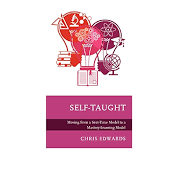U.S. Education is in Trouble, Let’s Fix It!
22 Education Reform Strategies for Immediate Implementation.
 Richard Garrett is a trained industrial engineer with a BS and MS from Purdue University, and a PHD in operations research from Northwestern University. After 27 years with the Eli Lily and Company, Garrett has dedicated his time and energy to studying the U.S. public education system.
Richard Garrett is a trained industrial engineer with a BS and MS from Purdue University, and a PHD in operations research from Northwestern University. After 27 years with the Eli Lily and Company, Garrett has dedicated his time and energy to studying the U.S. public education system.
There is a crisis in the education system. Teachers are ill-equipped to deal with disruptive students, resulting in lost classroom time and demoralized educators. It is a lack of character and grit, not a lack of intellectual ability, that prevents these children from behaving.
In his research, he concludes significant reforms are needed to save the decay of the education system in the United States. This book is a follow-up to Dr. Garrett’s first book, The Kids Are Smart Enough, So What’s the Problem? His second book features comprehensive and diverse topics with actionable recommendations based on each school’s needs.

Garrett identifies what he believes are the four primary reasons for the decline of our public school system: parenting issues, mismanagement by superintendents and school boards, runaway discipline problems, and social promotion (children moving to the next grade without having them meet the necessary requirements).
His analysis is compelling — and frightening.

Richard Garrett’s proposals to reform public education are data-driven and supported by the testimony of public-school teachers, administrators, education scholars, and experts in the field. There is no doubt that the system needs reform in many ways. Garrett’s book exposes the root causes of its failures and provides 22 workable solutions.

Richard Garrett presents a blueprint of 22 workable pillars that might be able to hold up America’s, top-heavy, and collapsing educational structure. These twenty-two pillars are reinforced by scholars, teachers, and common sense. Policymakers should read Garrett’s blueprint, and enact his advice, before the collapse gets any worse.
Let me paint you a picture from personal knowledge: Students hitting other students. Students throwing things in class. Fist fights in hallways. Students screaming at the top of their lungs and cussing back at teachers. Students are out of control!
These outrageous behaviors aren’t unique or rare. They have increased over the last four decades and many teachers are no longer willing to tolerate in-your-face disrespect. Teachers are quitting and this is the exact experience of my daughter. She received a Master’s degree in Education, taught elementary students for eight years in Florida, received a number of teaching awards, but eventually became emotionally drained, and ultimately left the profession like many of her colleagues.
This personal example is just one of the many issues raised by Richard Garrett in his book U.S. Education Is In Trouble, Let’s Fix It! 22 Reform Proposals. Dr. Garrett stresses that public education in the United States is in crisis and the likelihood of improvement is remote without major effort to correct the system. He presents significant information that lays out fundamental weaknesses and issues impacting education in the United States from cultural thinking and educational structure to policies and financing. The book contains seventeen chapters, covering a wide range of topics. I will not attempt to summarize each chapter but want to address below my perception of the major take-a-ways, plus his suggested pathway forward.
Cultural thinking is a broad term used to cover several points Dr. Garrett discusses to address how things have spiraled down. He first notes the “the self-esteem movement” that took hold in the 1970s. Under this concept, we want the student to feel good about and him/herself. Schools and communities bought into this misguided approach by protecting children from failure and feeling bad about themselves. A variety of outcomes resulted from this approach like grade inflation, where over 40% of children receive the letter grade ‘A’. What is the message young people can interpret from this kind of outcome? It is obvious that they do not have to work hard to find success, wealth, etc. They will not experience failure, learn by their mistakes, or develop grit to deal with adversity.
Classroom culture and student discipline have dramatically changed. One meaning of discipline is training or experience that helps shape a student’s thinking. It helps create an orderly and controlled environment to promote more effective learning environment, so students learn self-control, develop
skills to make good choices, and work well with others. Unfortunately, as noted above, respect and discipline have vanished from the classroom in many cases. Numerous policies have been adopted and legal decisions have been made to determine what is allowed in the classroom, and in most cases there no way a teacher can reprimand a student for inappropriate behavior. However, the teacher still has to deal with the disruptive student. Therefore, the learning environment has been sabotaged by a few
unruly students, with conscientious students losing value learning time.
Education Structure in the United States is not 100% uniform, but it is close. Most boards of education oversee the schools in their communities. They are populated with elected officials, representing different perspectives of the community. In most cases, parents of students populate the board and address issues they feel are appropriate for their children. Unfortunately, they do not always address the needs of a broader perspective to educate young minds. In many cases, they have an agenda to support their direct offspring, especially if they have some deficiency. This makes the implementation of policy within the school corporation problematic. Additionally, most school corporations have unions representing their teachers. These unions have an agenda that are not really focused on students, but on the teacher constituency, with work rules, retention, seniority, and salary issues being of primary interest.
Educational policies govern much that can take place in the in the classroom. There are numerous directives from national, state, and local levels that Dr. Garrett discusses. However, they do not lead to the creation of an effective learning outcome. Probably the most useful policy/directive should focus on the initiation of learning for a young person. As noted in Dr. Garrett’s book, the primary education objectives of guiding a three-year old child’s growth should see they receive the proper amount of brain stimulation. Both home and pre-K are critical starting points for long run success. Receiving the right kind of guidance at an early age is the foundation for long term success in any form of learning and molding of character.
At the secondary education level, Dr. Garrett suggests that curriculum tracking in schools would have better results for students. Designing curriculum that requires all students to take the same material is unrealistic, since students vary in capacity. Not all individuals have the same aptitude and skill to master advanced science and mathematics. Those individuals who have advanced capabilities should be tracked into college preparation coursework. Others not needing certain math and science skills, might be better suited to go into certificate vocational training.
Financial Impact of education, as stated by Dr. Garrett, is central to the student and the United States as a whole. The American student must master knowledge, gain lifelong skills, and develop the fortitude to succeed. These ingredients are necessary for success. As shown in many a study, a good education is the pathway to financial reward. In a similar way, the country as a whole benefits by a better educated society. They can create innovative ideas, foster cohesive work groups, and develop a common focus for improvement. As stated in on page 115 of Dr. Garrett’s book, “The quality of schooling in the country is a reliable predictor of the wealth that country will produce in the long run”.
While billions of dollars are spent annually for education in the United States, much is not focused on the primary goal of supporting the teacher in the classroom. The mission should have teachers maximize their platform time in front of the student, providing critical instruction. However, Dr. Garrett notes a number of government agencies require completing paperwork that takes away valuable time from the teacher, increasing the burden of their workload. Also, increasing the number of administrative staff in school corporations has significantly reduce the available funding for direct support in the classroom.
While I have attempted to provide an overview of the more critical items noted by Dr. Garrett in his book, he has done an excellent job of collecting data and researching the many issues concerning the complex task of educating young people. While it is easy to identify problems and shortcomings, he also puts forward a pathway for improvement. He describes the success in the state of Massachusetts to improve the quality of education for all students and the financial impact for the state. Not done
overnight and requiring strong legislative support to fund and monitor progress. But it worked!
If you are interested the United States public education system, this book is an important read, exploring the many facets that control this critical function in our society. Public education clearly needs improvement, and understanding all the issues and stakeholders is important.